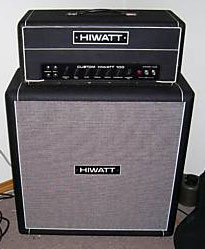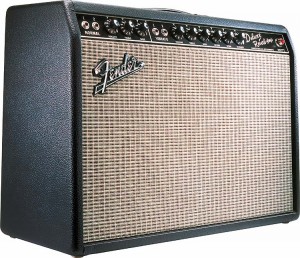"MetroAmp.com is your resource for everything you need for repairing, restoring or modifying your vintage (or not so vintage) Marshall." This is the claim made by George Metropoulos at Metropoulos Amplification. In my case, I was in search of a replica point-to-point circuit board for my Marshall JTM-45 reissue. Did MetroAmp.com deliver? Not only did MetroAmp.com deliver; they gave me the product and information to help complete my quest for a vintage Marshall JTM-45.
Read More »
Category Archives: Amplifiers
All About Ohms
Electrical resistance within speakers, amplifiers, as well as all basic electrical connections, is expressed in ohms, named after George Simon Ohm, a German physicist. While we needn’t go into the background of him and his achievements, or even the heavy details about resistance, ohms, or impedance, this is an area that is often confusing to people. The following is a primer all about ohms and how it relates to speakers and amplifiers. My hope is that very simply, any confusion on the topic will be eliminated.
Read More »
100 Watt Marshall Super Lead
The 100 Watt Marshall Super Lead was THE amp that started it all for the greatest rock and roll tones achieved – or I should say, the greatest LOUD rock and roll tones of the 60’s. Yes, the Vox AC 30, Fender Bassman, and even the Marshall JTM 45 came well before Marshall’s famous 100-watter, but it was the Super Lead that upped the ante for high-powered rock performances and really is the standard by which all rock guitar tone is judged. With generations of guitar greats such as Jimi Hendrix, Jimmy Page, Edward Van Halen, and countless others all using the Super Lead with stacks of 4 x 12 cabinets, there is no wonder why this amplifier is legendary; especially the very earliest models, known as the "plexi" heads.
Read More »
The Hiwatt Custom 100 DR103
 When Marshall amplifiers became wildly popular on the music scene in the mid 60’s, clone and copy makers soon followed with their own versions of the famous Marshall Super Lead design. It needs to be noted that Hiwatt was NOT one of these companies. In fact, what may appear at first as a simple variation and copy on the Marshall SuperLead in what was the form of the Hiwatt Custom 100 DR103 head, further examination quickly reveals that the design itself was actually far from it.
When Marshall amplifiers became wildly popular on the music scene in the mid 60’s, clone and copy makers soon followed with their own versions of the famous Marshall Super Lead design. It needs to be noted that Hiwatt was NOT one of these companies. In fact, what may appear at first as a simple variation and copy on the Marshall SuperLead in what was the form of the Hiwatt Custom 100 DR103 head, further examination quickly reveals that the design itself was actually far from it.
Read More »
The Marshall Shopper’s Guide Part 2: Metal Panel JMP to the JCM 2000
 We love our Marshall amps! The purpose of this article is to recognize the various changes in the amplifiers from the “metal panel” era of the JMPs from to the JCM 2000 series so that the potential buyer can be better educated. Some deliver the goods better than others and I’ve owned many Marshall amps over the years and had to learn the hard way after plenty of dollars spent. Ultimately though — use your own ears and compare. Enjoy the next installment of our Marshall Shopper’s Guide.
We love our Marshall amps! The purpose of this article is to recognize the various changes in the amplifiers from the “metal panel” era of the JMPs from to the JCM 2000 series so that the potential buyer can be better educated. Some deliver the goods better than others and I’ve owned many Marshall amps over the years and had to learn the hard way after plenty of dollars spent. Ultimately though — use your own ears and compare. Enjoy the next installment of our Marshall Shopper’s Guide.
Read More »
The Marshall Shopper’s Guide Part 1: Marshall Plexi Era
One of the most common questions we get here is, “What kind of Marshall amp should I buy?” We get countless questions not only about what type to get, but also questions about specific vintage vs. newer models, higher powered vs. lower powered models, types of speakers and how do they all sound, etc.
Read More »
The Overlooked Upgrade: Guitar Output Transformers
One of the common questions we receive here is, "How can I get my (fill in the blank with your favorite brand name) reissue amplifier to sound like the original?" Often times the question will contain additional information of what had been done already. "I’ve replaced the preamp and power tubes and gotten it biased, but it still sounds cold and brittle…"
Read More »
Weber Speaker Upgrade for Fender Deluxe Reverb Reissue
 We’ve often discussed at LegendaryTones the fact that your tone can often only be as strong as its weakest link. With amplifiers themselves, often the weakest link turns out to be the speaker used. When thinking about the individual cost of the speakers and comparing that with the other individual components that make up an amplifier, speakers turn out to be one of, if not the most, expensive pieces used. So what does this often translate to for manufacturers looking to cut costs? You guessed it – throw in cheaper speakers.
We’ve often discussed at LegendaryTones the fact that your tone can often only be as strong as its weakest link. With amplifiers themselves, often the weakest link turns out to be the speaker used. When thinking about the individual cost of the speakers and comparing that with the other individual components that make up an amplifier, speakers turn out to be one of, if not the most, expensive pieces used. So what does this often translate to for manufacturers looking to cut costs? You guessed it – throw in cheaper speakers.
Read More »
Celestion Speakers Explored
The old adage, "a chain is only as strong as its weakest link" can definitely be applied to the topic of speakers. Worn or mismatched speakers in wattage or impedance (ohms) are one thing, but different speaker designs also provide dramatic changes in tone and response for guitarists. And this is an area that is all too often neglected.
Read More »
Hiwatt Reissue Custom Shop 4×12 Cabinet & Weber Thames Speakers: Learning About the Hiwatt Fane Sound
A Brief Early History
As Marshall quickly grew in reputation as the new king of high-powered guitar amplification during the early 1960’s, Dave Reeves, who had been an employee of Mullard as well as a contractor for Sound City in London, began working on his own amplifiers that aimed to take the amplification construction quality and tonal designs to new heights. Reeve’s new Hiwatt amplifiers were born via his company, Hylight Electronics.
Read More »